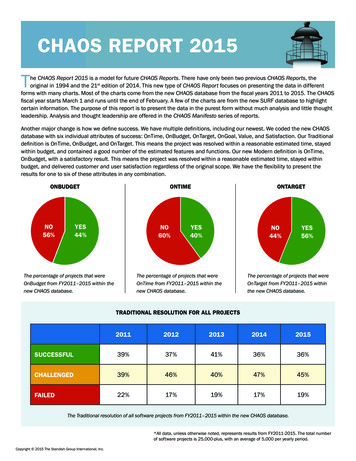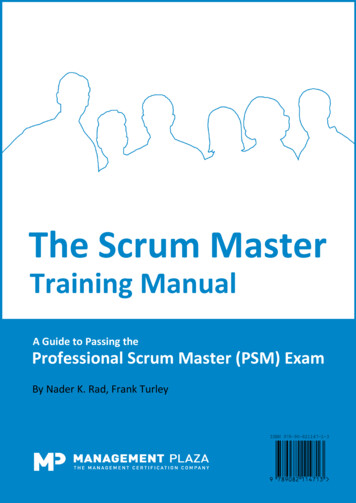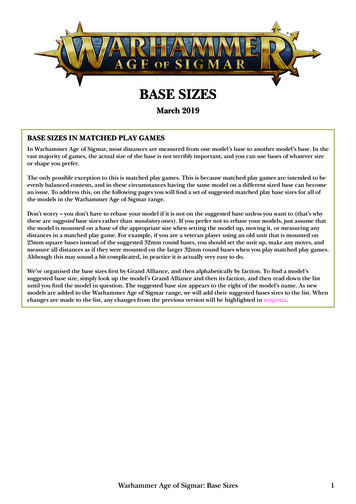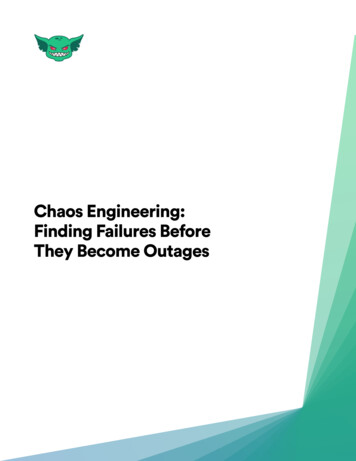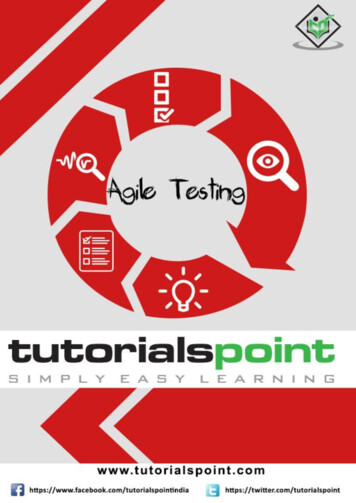
Transcription
CHAOS MANIFESTO 2013Think Big, Act Small
THE CHAOS MANIFESTO
TABLE OF CONTENTSPREFACEIntroduction . . . . . . . . . . . . . . . . . . . . . . . . . . . . . . . . . . . . . . . . . 1Executive Management SupportUser Involvement. . . . . . . . . . . . . . . . . . . . . . . . . . . . . . . 5. . . . . . . . . . . . . . . . . . . . . . . . . . . . . . . . . . . . . . 9Optimization . . . . . . . . . . . . . . . . . . . . . . . . . . . . . . . . . . . . . . . . .13Skilled Resources . . . . . . . . . . . . . . . . . . . . . . . . . . . . . . . . . . . . . .17Project Management Expertise . . . . . . . . . . . . . . . . . . . . . . . . . . . . . . . .21Agile Process. . . . . . . . . . . . . . . . . . . . . . . . . . . . . . . . . . . . . . . .25Clear Business Objectives . . . . . . . . . . . . . . . . . . . . . . . . . . . . . . . . . .29Emotional Maturity . . . . . . . . . . . . . . . . . . . . . . . . . . . . . . . . . . . . . .33Execution . . . . . . . . . . . . . . . . . . . . . . . . . . . . . . . . . . . . . . . . . .37Tools and Infrastructure. . . . . . . . . . . . . . . . . . . . . . . . . . . . . . . . . . .41Summary . . . . . . . . . . . . . . . . . . . . . . . . . . . . . . . . . . . . . . . . . .45THE CHAOS MANIFESTOCopyright 2013. The CHAOS Manifesto is protected by copyright and is the sole property of The Standish Group International, Incorporated. It may notunder any circumstances be retransmitted in any form, repackaged in any way, or resold through any media. All rights reserved.
PREFACECHAOS Manifesto 2013: Think Big, Act Small is a subset of the online version of theCHAOS Chronicles, known as the CHAOS Knowledge Center (CKC). This version ofthe CHAOS Manifesto focuses on small projects and is based on the CKC version40-12. The online CHAOS Chronicles contains 100 Best Practice Points and 300practice elements. CHAOS Chronicles is a work in progress, and new research isadded and updated every month along with other supporting features. Currentlythere are more than 900 charts in the CKC. This report is broken into 12 mainsections. Sections 2 to 11 cover the CHAOS Success Factors for Small Projects.The Standish Group has been collecting case information on real-life ITenvironments and software development projects since 1985. We get manyquestions about how we populate the CHAOS database. First, you should understand weare analysts and advisors, not data collectors. Second, each piece of data and every projectis reviewed thoroughly by an analyst before it goes in the database. Third, we have a standardand nonstandard list of questions to determine the accuracy of the data given to us that goes intothe database. Fourth, nothing is taken at face value and everything is questioned. Fifth, we havebeen rebuilding the CHAOS database starting in June 2012 to create a standard format. The newdatabase will be used to present the current data analytics.CHAOS Manifesto is based on the collection of project case information on real-life IT environmentsand software projects. This version and past versions have used eight different instruments in thecollection of this information, which includes project profiles, project tracking, individual projectsurveys, case interviews, general surveys, project postmortems, and other instruments. CHAOSresearch encompasses 18 years of data on why projects succeed or fail, representing more than90,000 completed IT projects. However, for our new database we eliminated cases from 1994though 2002, since they did not match the current requirements for analysis. The new databasehas just under 50,000 projects.CHAOS DEMOGRAPHICS: CHAOS results provide a global view of project statistics but do tend tohave a heavier concentration on the United States and Europe. For each reporting period, about60% of the projects are U.S. based, 25% are European, and the remaining 15% represent the restof the world. A little more than half of the companies are considered Fortune 1000-type companies;another 30% would be considered midrange; and 20% are in the small-range category. They spana diverse number of vertical industries and organizations. Participants are made up of a variety ofCIOs, VPs, directors, and PMO project managers.THE CHAOS MANIFESTOCopyright 2013. The CHAOS Manifesto is protected by copyright and is the sole property of The Standish Group International, Incorporated. It may notunder any circumstances be retransmitted in any form, repackaged in any way, or resold through any media. All rights reserved.
INTRODUCTIONThe 2012 CHAOS results show another increaseCHAOS RESOLUTIONin project success rates, with 39% of all projectssucceeding (delivered on time, on budget, withSuccessful39%43%required features and functions); 43% wereFailedchallenged (late, over budget, and/or with less thanChallengedthe required features and functions); and 18% failed(cancelled prior to completion or delivered and neverProject resolution from18%used). These numbers represent an uptick in the2012 CHAOS research.success rates from the previous study, as well as adecrease in the number of failures. The low point inthe last five study periods was 2004, in which only 29% of the projects were successful. This year’sresults represent a high watermark for success rates in the history of CHAOS research.The increase in success is a result of several factors, including looking at the entire projectenvironment of processes, methods, skills, costs, tools, decisions, optimization, internal andexternal influences, and team chemistry. Advances in the understanding of the skills needed to bea good executive sponsor have proved to be very valuable for increasing success rates. Increasesin project management as a profession and trained project management professionals can betied directly to increases in success rates. In addition, we have seen an increase in the numberof smaller projects and agile projects. Further, we have seen a decrease in waterfall projects.However, success does not come without a cost. It has come with an increase in project overhead,along with a reduction in value and innovation.The use of project health checks, retrospectives, dashboards, and tracking systems provides for anearly warning system so corrective actions can be taken. More than 90% of organizations performsome type of project postmortems or closeout retrospectives. Most organizations are finding thatthese end-of-project reviews are helpful for improving their next project and their general projectpractices. However, very few organizations capture this information in standard electronic format,and many times the information is lost or forgotten. It is one of the reasons we see initial projectimprovement, and then find that organizations backslide into old bad habits. Eternal vigilance is theprice of success. This is the purpose behind The Standish Group’s Project Service Advisory (PSA).The single most important advancement to improve project success rates is the increase in competencyof the executive sponsor. In our opinion, the executive sponsor is the owner of the project. As ownerof the project, this person has the full weight and responsibility for the success or failure of the projectsquarely on his or her shoulders. The role of an executive sponsor is not so much chief executive officer,but more “chief enabling officer.” As chief enabling officer, the executive sponsor’s job is to make surehe or she provides the support, resources, and guidance to allow the project team to be successful. Thisis the reason for our Executive Sponsor Appraisal %42%43%Project resolutionresults from CHAOSresearch for years2004 to 2012.THE CHAOS MANIFESTO1Copyright 2013. The CHAOS Manifesto is protected by copyright and is the sole property of The Standish Group International, Incorporated. It may notunder any circumstances be retransmitted in any form, repackaged in any way, or resold through any media. All rights reserved.
OVERRUNS AND FEATURESTime and costoverruns, pluspercentage offeatures deliveredfrom CHAOS researchfor the years 2004 S64%68%67%74%69%Determining the relationship of project overruns to features delivered is an analytical process. Ananalyst reviews each challenged project. This year’s figures show a slight increase in both cost andtime overruns. Cost overruns increased from 56% in 2004 to 59% in 2012. Time overruns alsohave gone up, from 71% in 2010 to 74% in 2012. The high point in time overruns was 2004 (84%).Features and functions developed went down, with 74% of specified requirements completed in2010, dropping to 69% in 2012. We think this could be a good sign as organizations spend moretime focusing on high-value requirements versus completing 100% of the requirements.Our analysis suggests that 20% of features are used often and 50% of features are hardly everor never used. The gray area is about 30%, where features and functions get used sometimes orinfrequently. The task of requirements gathering, selecting, and implementing is the most difficultin developing custom applications. In summary, there is no doubt that focusing on the 20% of thefeatures that give you 80% of the value will maximize the investment in software development andimprove overall user satisfaction. After all, there is never enough time or money to do everything.The natural expectation is for executives and stakeholders to want it all and want it all now.Therefore, reducing scope and not doing 100% of the features and functions is not only a validstrategy, but a prudent one.Very few large projects perform well to the project management triple constraints of cost, time,and scope. In contrast to small projects, which have more than a 70% chance of success, a largeproject has virtually no chance of coming in on time, on budget, and within scope, which is TheStandish Group definition of a successful project. Large projects have twice the chance of beinglate, over budget, and missing critical features than their smaller project counterparts. A largeproject is more than 10 times more likely to fail outright, meaning it will be cancelled or will not beused because it outlived its useful life prior to implementation.It is very clear that reducing scope and breaking up large projects are difficult tasks. However, therewards and benefits are quickly evident when the organization starts to receive value early in theproject cycle. We, the writers, also have come to believe that there is no need for large projects,and that any IT project can be broken into a series of small projects that could also be done inparallel if necessary. One should not confuse breaking down projects into milestones, phases,critical paths, and activities as small projects. Delivery of concrete and usable results demarks asuccessful completed project. Small projects deliver a valuable result that is actually used to createa return on investment (ROI). This is the purpose for the Standish OptiMix Solution and Clinic.2THE CHAOS MANIFESTOCopyright 2013. The CHAOS Manifesto is protected by copyright and is the sole property of The Standish Group International, Incorporated. It may notunder any circumstances be retransmitted in any form, repackaged in any way, or resold through any media. All rights reserved.
FACTORS OF SUCCESS FOR SMALL PROJECTSThe current 2013 Factors of Success in theFactors of SuccessCKC are unchanged from 2012. We haveExecutive management support20developed a special version of the FactorsUser involvement15of Success for Small Projects using our newOptimization15Skilled resources13Project management expertise12Agile process10has executive sponsorship as the number oneClear business objectives6factor, but the prioritization of some of theEmotional maturity5other factors shifts.Execution3Tools and infrastructure1CHAOS database and analytic tools. The smallproject version of the Factors of Success alsoExecutive Management Support: The most importantperson in the project is the executive sponsor. Theexecutive sponsor is ultimately responsible for thesuccess and failure of the project. We give executivesponsorship 20 small project success points.User Involvement: CHAOS research clearly shows thatprojects that lack user involvement perform poorly. Userparticipation has a major effect on project resolutionlarge or small; in fact, we give it 15% of our small projectsuccess points.Optimization: Is in the third spot for small projects. Ifwe defined optimization as a project with a small laborcontent and fast delivery, it could be number one. Sizeand complexity trump all other factors. Optimization gets15 small project success points.Skilled Resources: In the fourth position and with 13small project success points, it may seem that skilledresources gets no respect, but that is not true. A projectis made up of people, and success is on their shoulders.This is especially true for small projects.Project Management Expertise: We might also callit process management expertise. In any case, it isessential to controlling the progression of small projectsand the collaboration of the stakeholders and teammembers. Project management expertise accounts for12 small project success points out of 100.PointsAgile Process: Embodies the small project philosophy.The agile process directly addresses user involvement,executive support, and the other success factors. Wegive the agile process 10 small project success points.Clear Business Objectives: A less important ingredientfor small projects than larger projects. Still, the smallproject should have a business objective, though it mightbe less clear. Even so, all projects should align theorganization’s goals and strategy, which is why it has 6of the small project success points.Emotional Maturity: Covers the emotional state ofthe project environment. Projects get resolved withinthe ecosystem; a healthy ecosystem produces moresuccessful projects. Emotional maturity accounts for 5small project success points.Execution: Is the process that governs and controls theproject. Much of this factor focuses on financial controlsand procedures. We give execution 3 small projectsuccess points.Tools and Infrastructure: They can help a projectsucceed, but like any tool they can also hurt.Organizations must be extremely careful not to rely toomuch on tools for a project’s success. We give thisfactor only 1 small project success point.The first five success factors focus on the execution of small project skills, and provide the greatest benefit forsuccess. The first three success factors account for 50% of the points while all five account for three-quarters of thepoints. The last five success factors help, but provide the least benefit for success, with a total of 25 points out of100. The Standish Group further breaks down the success factors into points and assigns fractions of the scores toeach of these points. The main body of this report outlines the CHAOS 100 Best Practices for Small Projects or whatwe call Success Points for Small Projects.THE CHAOS MANIFESTO3Copyright 2013. The CHAOS Manifesto is protected by copyright and is the sole property of The Standish Group International, Incorporated. It may notunder any circumstances be retransmitted in any form, repackaged in any way, or resold through any media. All rights reserved.
THINK BIG, ACT SMALLThe New York City Automated Payroll (NYCAP) System started in 1999 and was declared completedin 2011. The budget and original estimate was 66 million. When the project was declaredcompleted, the total cost was an astounding 360-plus million, or 5.5 times the original budget.The NYCAP project was one of many large troubled projects in the New York City government aroundthis time. Another project was the CityTime project, which had a budget of 63 million over fiveyears, but ultimately cost 700 million over 10 years. In reaction to these projects’ challenges, theNYC Council passed an ordinance that any IT project that exceeded the budget by more than 10%must report to the City Council.While there were many reasons why these NYC projects failed to perform as planned, oversightwas not one of them. However, the NYC Council’s reaction to these project management failureswas typical, predictable, and disappointing. It was disappointing because adding more layersof bureaucracy on top of an overbloated process will make future projects more complicated,more expensive, and more challenging. The Standish Group has categorically stated with muchconviction—backed by intense research—that the secret to project success is to stronglyrecommend and enforce limits on size and complexity. These two factors trump all others factors.Considering size and complexity as the major success factors has led us to some very interestingconclusions and challenges.It is critical to break down large projects into a sequence of smaller ones, prioritized on directbusiness value, and install stable, full-time, cross-functional teams that execute these projectsfollowing a disciplined agile and optimization approach. Organizations that have adopted thisapproach have seen major project improvement and their project investments have increased. Moreand more companies are recognizing that a small project optimization solution is highly effective.The quick solution is to just say no to large projects, but the more sensible answer is to adopt asmall project strategy. Many companies routinely deliver software at half the cost and less than halfthe defects with this strategy.Projects too often get too big to succeed. CIOs and information technology executives are constantlybeing called on to do more for less. The real key to success is doing less for less. The key to doingless for less is splitting large projects into a sequence of small ones by using optimization; theStandish OptiMix is an example of an optimization tool. Optimization can save your company, yourproject, your budget, and your job. Throughout the CHAOS Manifesto 2013 we will attempt to showyou how you can optimize your projects successfully.CHAOS RESOLUTION BY LARGE AND SMALL PROJECTSProject resolution for thecalendar year 2012 in thenew CHAOS database. Smallprojects are defined asprojects with less than 1million in labor content andlarge projects are consideredprojects with more than 10million in labor content.4Small ProjectsLarge %THE CHAOS MANIFESTOCopyright 2013. The CHAOS Manifesto is protected by copyright and is the sole property of The Standish Group International, Incorporated. It may notunder any circumstances be retransmitted in any form, repackaged in any way, or resold through any media. All rights reserved.
SUCCESS FACTOR ONE: EXECUTIVE MANAGEMENT SUPPORTAll projects need to have a committed executive sponsor or product ownerwho supports the project and takes responsibility for the outcome. Lesson One inthe CHAOS Knowledge Center (CKC) outlines the skills and the responsibilities ofthe executive sponsor. Executive management support is also the first Factorof Success for Small Projects. Our Executive Sponsor Appraisal tests theseskills. Small projects allow a new or inexperienced executive sponsor to gainexpertise while not burdening his or her main job function. Here, the CHAOS 10Success Points for Executive Support are modified for small projects.The nice thing about small projects is they don’t require high-powered executivesponsors—they should be reserved for transformational and large projects. Smallprojects need a skilled and engaged executive, but the executive could be a midlevelmanager—or in the case of agile, a product owner—who is enthusiastic about the success ofthe small project. However, if a high-powered executive sponsor adopts a small project as his or herpet project, all the more power to the team.In addition to not needing a high-powered executive sponsor, the executive sponsor does not requirea detailed project plan because the tasks and schedules are fairly straightforward and well known.There is little need for critical path analysis since there is generally only one or two paths. A basicstatement of work coupled with a concise problem, goal, and vision statement should suffice asthe project plan. There should be a concise progress board and a weekly memo that the executivesponsor reviews.With small projects, negotiation should be kept to a minimum. Standard contracts, or better yet justmemos of understanding, should be used to get the project going. You do not want to spend moretime and money on negotiating the project than doing the project. Detailed business plans are reallyunnecessary for small projects. A one- to two-page vision statement with the values of the project isall that should be required to fund, approve, or reject a small project.Kill switches are always recommended to prevent runaway projects. Small projects often have anatural kill switch, which is the end of the funding. For many small projects, a single kill switchmight be appropriate.SKILL LEVEL OF THE EXECUTIVE SPONSORHighlyModeratelySkilled SkilledSkilledIn understanding whatinspires the project teamPoorlySkilled11%62%18%9%In celebrating large and smallaccomplishments9%47%27%16%In recognizing team membercontribution – big and small8%59%17%16%12%59%8%21%6%44%27%22%In rewarding someone ofoutstanding effortIn giving a celebration partyRespondents wereasked to rate their ITmanagement’s skillin influencing andeducating the projectexecutive sponsors onthe listed skills.THE CHAOS MANIFESTO5Copyright 2013. The CHAOS Manifesto is protected by copyright and is the sole property of The Standish Group International, Incorporated. It may notunder any circumstances be retransmitted in any form, repackaged in any way, or resold through any media. All rights reserved.
10 CHAOS SUCCESS POINTS FOREXECUTIVE MANAGEMENT SUPPORT FOR SMALL PROJECTSPoint 1: Simple VisionWith small projects, the vision may be part of a large program, and therefore the simple vision should becommunicated in the context of how the small project fits into the large program. The executive sponsorwill then need to work on building a consensus among the stakeholders and tying their understanding ofthe small project back to the vision statement of the larger program.Point 2: CommitmentIt is always hard to get commitments and time from executives. Small projects provide for a reducedcommitment of time and effort. Small projects also have more defined objectives that the executivesponsor can champion. Further, it is easier for the executive sponsor to pave the way for success byrecruiting other supporters and neutralizing distracters because of the reduced visibility of the smallerproject.Point 3: BlinkThe larger the project, the more decisions that have to be made. The Standish Group rule of thumb is1.5 decisions for every 1,000 in labor cost. A million-dollar project will have 1,500 decisions, while a 10 million project will have 15,000. The executive sponsor will be required to participate in about 20%of these decisions. The difference is 300 decisions versus 3,000 decisions.Point 4: VelocityA steppingstone activity allows for tangible inspection either visually or hands-on. The steppingstonemethod is the key factor in creating and maintaining decision velocity. Executive sponsors who can seeboth progress and output help the team make the other 80% of the decisions in a more concrete andrapid fashion.Point 5: EducationOur research clearly shows that projects where the executive sponsor has a fair to poor understanding ofthe project management process fall into both the challenged and failed categories. Those projects withexecutive sponsors who have a high to moderate understanding do much better. Small projects providethe organization with the ability to reduce processes and governance, thus improving the executivesponsor understanding.RESOLUTION BY GOAL20%The chart shows the resolutionof small projects with goalsthat match the THE CHAOS MANIFESTOCopyright 2013. The CHAOS Manifesto is protected by copyright and is the sole property of The Standish Group International, Incorporated. It may notunder any circumstances be retransmitted in any form, repackaged in any way, or resold through any media. All rights reserved.
SKILL LEVEL OF THE 6%34%19%Time commitment14%47%28%11%Vision and otivation19%56%14%11%General skillsVeryImportantCIOs wereasked to ratethe importanceof capturingpostmorteminformation onthe executivesponsor’s skills.Point 6: MeasurementsExecutive sponsors need an easy and visual way to measure progress. Successful project completionis contingent upon reaching specified goals. The closer the goal, the easier it is to reach. In football thegoalposts are 100 yards apart. All the players and fans can see the goalposts and note how progress ismeasured. Small projects have similar attributes.Point 7: NegotiateThe scope defines the boundaries of the project, such as the business functions and organizationsimpacted, as well as the constraints, such as deadlines, budget ceilings, and other assumptions.Negotiation between team members, stakeholders, and the executive sponsor on scope is a major partof all projects. It takes a skilled executive sponsor to negotiate scope for small projects.Point 8: The PlanThe smaller the project, the smaller the plan and the easier it is for the executive sponsor to absorb.The executive plan should include an overview of the solution as well as list all the major parts. Eachpart should be written using precise words that express the true meaning of the solution. It shouldhave diagrams or pictures illustrating how the parts fit together. The expected cost, ROI, and time tosuccessful completion should be included as part of the solution summary.Point 9: Kill SwitchThe purpose of a kill switch is to prevent death-march projects, which are all too common. With a deathmarch project, no one, including the executive sponsor, has the courage to stop it. Small projectshave a built-in kill switch, and because they are small the impact of stopping them is much less to theorganization. Like all projects, small projects need to have business triggers, technical triggers, andinvestment triggers.Point 10: CelebrateIt’s important to celebrate success. The executive sponsor should cultivate an atmosphere ofaccomplishment and focus on execution. Celebration allows the executive sponsor to rewardaccomplishment and behavior that will advance the progress of the project. When a goal is reached it isa good time to praise accomplishments. Small projects give the executive sponsor more opportunities tocelebrate.THE CHAOS MANIFESTO7Copyright 2013. The CHAOS Manifesto is protected by copyright and is the sole property of The Standish Group International, Incorporated. It may notunder any circumstances be retransmitted in any form, repackaged in any way, or resold through any media. All rights reserved.
EXECUTIVE SPONSOR APPRAISALIn 2012, we launched a new research center dedicated to the advancement and understanding ofthe role of the executive sponsor within IT projects. This center will provide focus on this particularsubject. Our first item for this new center is the Executive Sponsor Appraisal. The ESA measuresand reports on 50 skills over 15 different proficiencies. The major parts of the Executive SponsorAppraisal are database, question delivery and display, analyst engine, and reporting.Database: Questions and appraisals. Questions consist of the habit or skill name, narrative of theskill, and the question itself, plus the value score, difficulty score, and influence score. There arecurrently 50 entries in the question table. Standish advisors update the question table as needed.Question Delivery and Display: A process that helps guide the respondent while guarding againstbiased answers. Once a participant or participants sign on to the appraisal, a questionnaire isdynamically and randomly generated. The questions are displayed one at a time with the title,narrative, and question. The person then selects their skill level from very skilled to poorly skilled.Analyst Engine: Takes the appraisal data and measures it both in terms of raw scores andbenchmarks. The Standish Group created 15 measurements, including agility and flexibility, changemanagement, communication astuteness, and resolution promptness. Each of the 50 questions ismapped against these measurements both for skill level and benchmark.Report: Has four parts. The first page header has the name of participant, date of the appraisal,overall rank such as above or below average, and overall skill level. The second part of the firstpage is a table with 15 measurements, each with the skill level and benchmark rank. The secondpage lists the three most important skills with the narrative to increase the executive sponsor’sscore. The third page lists the three easiest skills with the narrative to increase the executivesponsor’s score. The fourth page lists the three skills with the narrative that IT can use to helpincrease the executive sponsor’s score.ESA REPORT EXAMPLEThis is an excerptfrom an ExecutiveSponsor Appraisalreport.8MeasurementsSkill LevelBenchmarkAgility and flexibilityModerately skilledBelow averageChange managementModerately skilledAbove averageClear business objectivesModerately skilledAverageCommunication astutenessSkilledTop 20%Emotional maturityPoorly skilledBottom 20%GovernanceModerately skilledAverageLeverage resourcesSkilledAbove averageMaking decisionsModerately skilledAbove averageMeasurement insightSkilledAbove averageProcess insightHighly skilledTop 20%Resolution promptnessModerately skilledAverageR
CHAOS Manifesto 2013: T hink B ig, Act Small is a subset of the online version of the CHAOS Chronicles, known as the CHAOS Knowledge Center (CKC) . This version of the CHAOS Manifesto focuses on small projects and is based on the CKC version 40-12 . The online CHAOS Chronicles contains 100 Best Practice Points and 300 practice elements .


